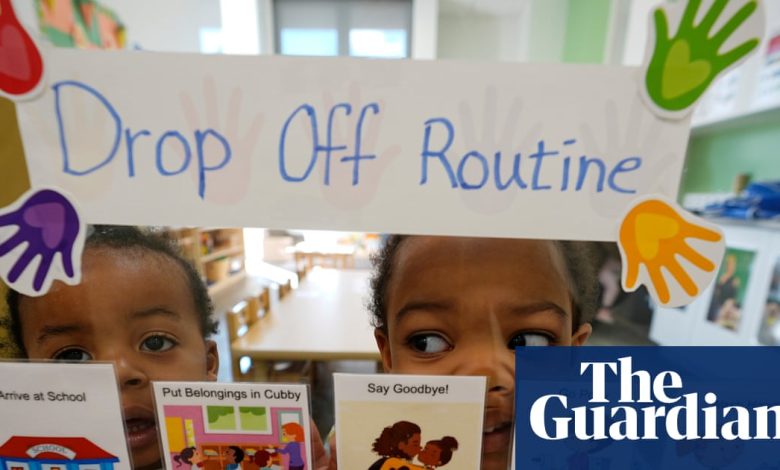Pandemic childcare funding is running out across the US: ‘The whole system is beginning to implode’ | Childcare

On an early fall day, toddlers played at Westwood Academy, a highly rated Denver childcare center serving children aged six weeks to five years. The room glowed with natural wood and light while preschoolers settled onto colorful floor circles to hear a book read aloud. “Where’s your circle?” one of the children asked the teacher.
Westwood is located in west Denver, a lower-income part of the city; median family income in the surrounding area is less than $43,000 a year, according to census data.
It is precisely because Westwood owner RB Fast serves this population that she and her peers are struggling to make the budgetary math work. The American childcare system, primarily a market-based, pay-to-play system, has always had inequities, but those inequities are growing ever sharper as federal pandemic-era funding, a boon to many families, has run out across the nation. Combine that with flat federal funding and for-profit childcare catering to affluent families, and, as Fast said, childcare “has become a service for high-income families, not low-income families”.
In January, Denver joined many other Colorado counties in freezing enrollment for the state’s childcare subsidy program known as the Colorado Child Care Assistance Program (CCCAP). Given the high percentage of Westwood families using subsidies – Fast said that when full, the center had two-thirds of children receiving CCCAP – the freeze has meant would-be enrollees cannot afford a slot. So when a family moves away, there is no one able to replace them, despite high demand.
As a result, Westwood has seven unfilled spots in its 16-slot preschool classroom. “I have slots available, and I could serve families tomorrow,” Fast said, “if there were subsidies.” The lack of public aid can also start a vicious cycle: when spaces are unfilled, revenue drops, and the bottom line falls apart for the whole program. If the CCCAP freeze continues indefinitely, Westwood’s future is uncertain.
Programs serving lower-income families commonly struggle to maintain stable operations, often relying on meager public subsidies available in each state through the federal Child Care and Development Block Grant (CCDBG). Even though these subsidies are inadequate – and nationally, only one in seven eligible families receive them due to underfunding – they can be a financial lifeline. During the Covid-19 pandemic, the federal government surged money to the states, and that money was used to stabilize program operations and provide financial relief to families.
Colorado, for instance, gave out more than $250m of such grants from 2021 to 2023, nearly double its current annual CCDBG allocation. Researchers from the Colorado Evaluation and Action Lab at the University of Denver found that the stabilization grants helped to keep programs open while allowing them to raise staff wages and reduce fees for parents. That was also the case nationally in states from Alabama to Alaska.
When the pandemic funding began to dry up in September 2023, the impacts predictably fell on lower-income families and communities of color with less wealth or ability to navigate the renewed scarcity. However, the funds’ expiration did not occur all at once; many states distributed remaining money for months if not years after, and about a dozen have used their own dollars to extend the stabilization funding.
Now, as the country wrestles with rising costs of living and economic uncertainty, pressures are again beginning to spike. No significant increase in CCDBG appears to be on the horizon, as budget bills moving through Congress hold federal funding largely flat.
Within this context, Philip Fisher, director of the Stanford Center on Early Childhood, noted that the center’s ongoing survey of families has begun seeing some of the highest rates of reported hardship since they began tracking in 2020. “The disproportionate impacts have been present for a long time, and they’re being exacerbated by the current circumstances,” Fisher explained, adding that with hardship rising even among families with young children in the middle- and upper-income brackets, “it becomes clear that the whole system is beginning to implode”.
The mother of a five-month-old, Denver resident Iyanah French went to apply for CCCAP when her child was born but was told the freeze meant she couldn’t even be placed on a waitlist. She found the experience “overwhelming”, adding that “you have to work in this world”. She eventually found a slot thanks to the non-profit supportive housing complex in which she lives.
Even within low-income populations, childcare scarcity can land unevenly. Colorado state representative Lorena Garcia is also executive director of the non-profit Colorado Statewide Parent Coalition. She noted that “English-speaking families are able to get information a little bit faster about what’s happening, so they can start looking for other options. But non-English-speaking families get their information a little bit later.”
Colorado parents aren’t the only ones feeling pinched by post-pandemic changes.As of 1 August, New Jersey froze enrollment in its childcare assistance program, citing a $30m budget shortfall. The state also told already-enrolled families to expect an increase in their monthly co-pays. Other states, including Arizona and Virginia, have not enacted freezes but have subsidy waitlists in the thousands. And in many states, even families able to wrangle a voucher face decreasing options for using them: childcare programs in places like Indiana and North Carolina have begun to close in significant numbers due to harsh economics and inadequate support, including the only licensed program on the latter state’s Hatteras Island.
Experts and advocates worry that the Republican budget-reconciliation bill passed this summer will worsen these trends. Melissa Boteach, chief policy officer at the non-profit Zero to Three, explained that Medicaid and Snap cuts will force state legislatures to use more scarce state dollars that could otherwise go to childcare. Both low-income families and childcare educators – many of whom are low-income themselves, due to the sector’s notoriously low compensation – will struggle with the personal impact of the cuts. Boteach said: “So on three fronts, even though the words ‘Child Care and Development Block Grant’ were not said in the One Big, Beautiful Bill, there’s going to be a lot of [childcare] pain, particularly for lower-income families and families of color, and families in rural areas.”
Still, there is a seeming paradox: despite the childcare sector’s myriad struggles, the total number of childcare programs has been modestly increasing in recent years. While there is no comprehensive data for 2025, the non-profit Child Care Aware of America reports from surveys of 40 states that the number of licensed centers nationally increased by more than 4,000 from 2022 to 2024. The increase is likely driven by growth among childcare programs that serve more affluent clienteles. For instance, Heather Tritten, president and CEO of the Colorado Children’s Campaign, a statewide non-profit, says that Colorado has also seen a small increase in licensed slots in the past year. Yet, Tritten questioned, with regards to equitable access: “Are they the right slots?” She added: “I think there’s sort of a dual economy when it comes to childcare: there’s the childcare that’s available for people who can afford childcare. And then there’s the childcare that is probably not available to people who are less able to afford it.”
Many of the experts interviewed for this story offered that the solution to equitable childcare access is not merely better funding for subsidy programs, but a transformed system that eliminates the two-tier distinctions altogether. Ideally, Garcia said, “our childcare system wouldn’t be a private business model. It would be a public good, and we would take lessons from K-12 so that we’re not overpromising and underfunding”, and “we would design the system on a needs-based model and not a profit-based model”.
There are indeed vast differences in how childcare and K-12 education are funded in the US, despite sharing many of the same features in terms of shaping children’s learning, supporting parents’ ability to work and serving as community infrastructure. The average per-child funding in K-12 education is more than $17,000, while it is less than $2,000 for early care and education. Shifting toward a more comprehensive childcare system could thus enhance social equality in a deeper sense: Tritten of the Colorado Children’s Campaign concluded: “It would be great to figure out how to have this conversation in a way that isn’t about just the haves and the have-nots, but about all children and the needs of all children. Because it doesn’t matter how much money your parents have, you still have the same needs in terms of what you need from birth until that first day of kindergarten to ensure that you’re ready for school.”
This article was produced in partnership with New America’s Better Life Lab
https://www.theguardian.com/us-news/2025/nov/01/covid-pandemic-childcare-funding




